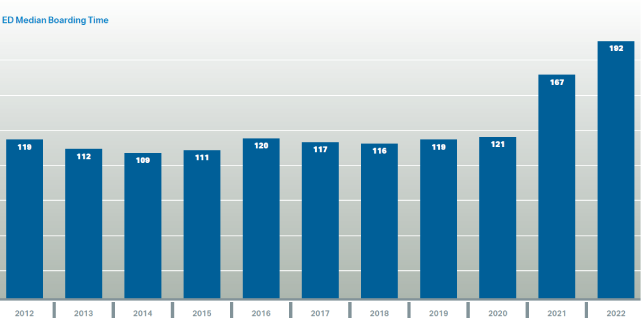
The Emergency Department Benchmarking Alliance (EDBA) is a membership organization composed of high-performance emergency departments (EDs) that share a commitment to quality. The preliminary 2022 report contained performance measures for 938 EDs that managed more than 46 million patient visits, plus 222 additional freestanding EDs that served more than 4 million patients. Thus, the survey included data for about one-third of all patients seen in US ED’s in 2022.
Explore This Issue
ACEP Now: Vol 42 – No 12 – December 2023Most Important Data Trends for Emergency Physicians and ED Leaders
Large losses (around 14 percent) in ED volume in 2020 reversed in 2021 and volumes increased further during 2022. In 2023, ED volumes are approaching those seen pre-pandemic at 66 percent.
EMS arrivals increased; many of those patients (35 percent) were admitted. A lower volume of walk-in patients resulted in a relative increase in patients arriving by EMS. Patient intake remained steady with median “Door to Bed” time decreasing to about eight minutes and “Door to Doctor” time to about 20 minutes. Long term trends remain intact, as these intake processing times decreased in most years since 2008, when the intake time was about 41 minutes.
Overall length of stay increased in EDs, with a subsequent large increase in the ED walkaway rate. The overall length of stay for all ED patients increased to 211 minutes in 2022, up from 194 minutes in 2021, 184 minutes in 2020, and 182 minutes in 2019. ED process times remain tightly correlated with volume of patients seen. Patients who require inpatient boarding remain a significant challenge to ed operations. About 19 percent of ED visits result in hospital admission and 66 percent of hospital admissions are processed through the ED. These numbers have been trending higher and 2022 was no exception.
The time interval referred to as ED boarding time has been part of the hospital’s required data submission to CMS since 2013. This is the time from “Decision to Admit” until the patient physically leaves the ED. Despite the work of ED and hospital leaders to reduce this time interval, Boarding Times had been stuck at around 120 minutes from 2013 to 2019. The pandemic saw the time interval increase. In the year 2021, the ED boarding time was 167 minutes, and in 2022 it soared to the 190-minute mark. This time interval is very cohort-dependent, ranging from 116 minutes in the smallest volume EDs, to 295 minutes in EDs that see more than 80,000 patients. The average ED Boarding Time of 190 minutes accounted for about 47 percent of the time the admitted patient spent in the ED. Unfortunately, the ED boarding measure is no longer required to be reported to CMS.1
Boarding time increases led to unprecedented ed walkaway rates. The percentage of patients who leave the ED prior to the completion of treatment increased to a stunning 4.9 percent in 2022, continuing its upward climb from 4.0 percent in 2021, 2.8 percent in 2020 and 2.7 percent in 2019. Even freestanding EDs saw a significant increase in walkaway rates, from 1.6 percent in 2019, to 2.7 percent in 2022. The overall rate of 4.9 percent in 2022 is unprecedented, troubling, and indicates significant dissatisfaction with the delivery of acute, unscheduled care. In 2020, U.S. EDs saw a total of 137 million patients. The walkaway rate of 2.8 percent that year meant that about 3.84 million ED visits ended prematurely. The increase in LBTC rates to 4.9 percent in 2022, combined with an estimated 155 million ED visits, means that about 7.6 million patients walked away. That is almost double in just two years.
Due to hospital boarding, it appears that ED leaders and emergency physicians cannot provide care that is timely and satisfies patients if the ED remains congested with inpatients. Inpatient boarders also take significant time and energy of the available ED nurses and techs, which leaves those individuals unable to assist in caring for the steady flow of new patients. Prior research shows that boarders worsen mortality; anecdotes from ACEP members echo the data.2,3 A solution to the boarding crisis is needed.
Emergency physicians have an opportunity to reduce walkaway rates by improving the timing to get to a decision, either to discharge or to admit. Many EDs have reduced the door to provider time, as evidenced in the reduction in that metric over many years. But if the admitted patient cannot be moved out of an ED bed, and it remains the responsibility of the ED nurses and techs to provide care for boarded patients, emergency physicians cannot marshal the resources to make the flow work, patients of all types have their hospital care compromised, and a large number will walk away not knowing if they have an emergency medical condition or not.
 Dr. Augustine is national director of prehospital strategy for US Acute Care Solutions based in Canton, Ohio; clinical professor of emergency medicine at Wright State University in Dayton, Ohio; and vice president of the Emergency Department Benchmarking Alliance.
Dr. Augustine is national director of prehospital strategy for US Acute Care Solutions based in Canton, Ohio; clinical professor of emergency medicine at Wright State University in Dayton, Ohio; and vice president of the Emergency Department Benchmarking Alliance.
References
- Rahman NA, Hemmer KC, Pines JM. ED boarding. ACEP Now. Published August 1, 2023. Accessed November 29, 2023.
- Boudi Z, Lauque D, Alsabri M, et al. Association between boarding in the emergency department and in-hospital mortality: A systematic review. PLoS One. 2020;15(4):e0231253.
- American College of Emergency Physicians. A nation in crisis: Real stories from the front lines. ACEP website. Accessed November 29, 2023.
Pages: 1 2 3 | Multi-Page




No Responses to “A Sobering Year for Emergency Departments and Their Patients”